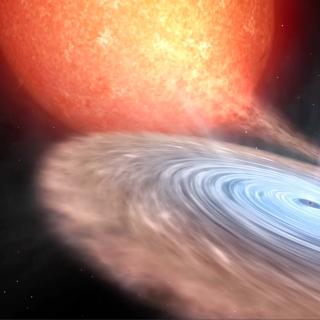Bibcode
Green, Matthew J.; Hermes, J. J.; Barlow, Brad N.; Marsh, T. R.; Pelisoli, Ingrid; Gänsicke, Boris T.; Kaiser, Ben C.; Romero, Alejandra; Amaral, Larissa Antunes; Corcoran, Kyle; Grupe, Dirk; Kennedy, Mark R.; Kepler, S. O.; Munday, James; Ashley, R. P.; Baran, Andrzej S.; Breedt, Elmé; Brown, Alex J.; Dhillon, V. S.; Dyer, Martin J.; Kerry, Paul; King, George W.; Littlefair, S. P.; Parsons, Steven G.; Sahman, David I.
Bibliographical reference
Monthly Notices of the Royal Astronomical Society
Advertised on:
1
2024
Citations
3
Refereed citations
3
Description
AM CVn-type systems are ultracompact, helium-accreting binary systems that are evolutionarily linked to the progenitors of thermonuclear supernovae and are expected to be strong Galactic sources of gravitational waves detectable to upcoming space-based interferometers. AM CVn binaries with orbital periods ≲20-23 min exist in a constant high state with a permanently ionized accretion disc. We present the discovery of TIC 378898110, a bright (G = 14.3 mag), nearby (309.3 ± 1.8 pc), high-state AM CVn binary discovered in TESS two-minute-cadence photometry. At optical wavelengths, this is the third-brightest AM CVn binary known. The photometry of the system shows a 23.07172(6) min periodicity, which is likely to be the 'superhump' period and implies an orbital period in the range 22-23 min. There is no detectable spectroscopic variability. The system underwent an unusual, year-long brightening event during which the dominant photometric period changed to a shorter period (constrained to 20.5 ± 2.0 min), which we suggest may be evidence for the onset of disc-edge eclipses. The estimated mass transfer rate, $\log (\dot{M} / \mathrm{M_\odot } \, \mathrm{yr}^{-1}) = -6.8 \pm 1.0$, is unusually high and may suggest a high-mass or thermally inflated donor. The binary is detected as an X-ray source, with a flux of $9.2 ^{+4.2}_{-1.8} \times 10^{-13}$ erg cm-2 s-1 in the 0.3-10 keV range. TIC 378898110 is the shortest-period binary system discovered with TESS, and its large predicted gravitational-wave amplitude makes it a compelling verification binary for future space-based gravitational wave detectors.
Related projects

Black holes, neutron stars, white dwarfs and their local environment
Accreting black-holes and neutron stars in X-ray binaries provide an ideal laboratory for exploring the physics of compact objects, yielding not only confirmation of the existence of stellar mass black holes via dynamical mass measurements, but also the best opportunity for probing high-gravity environments and the physics of accretion; the most
Montserrat
Armas Padilla